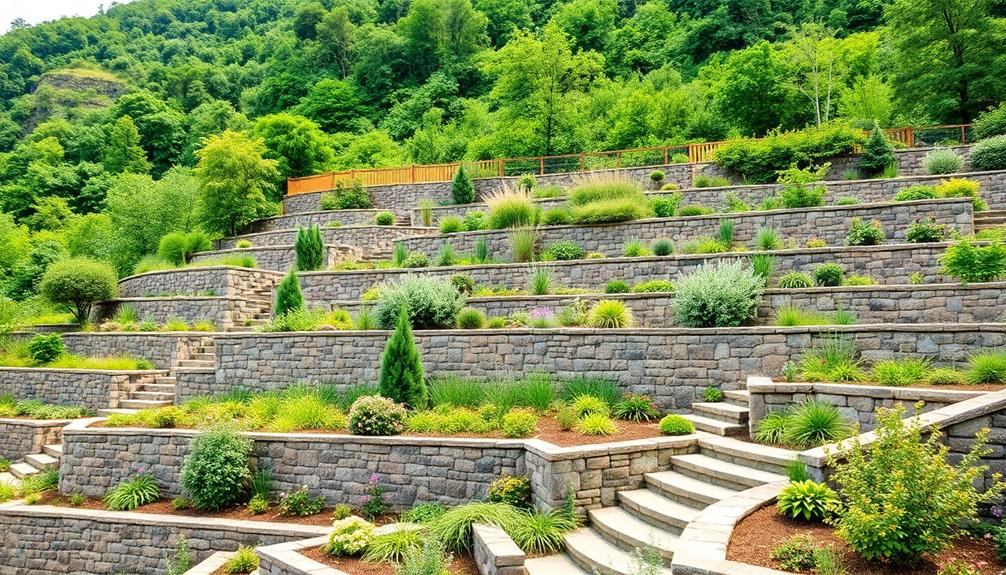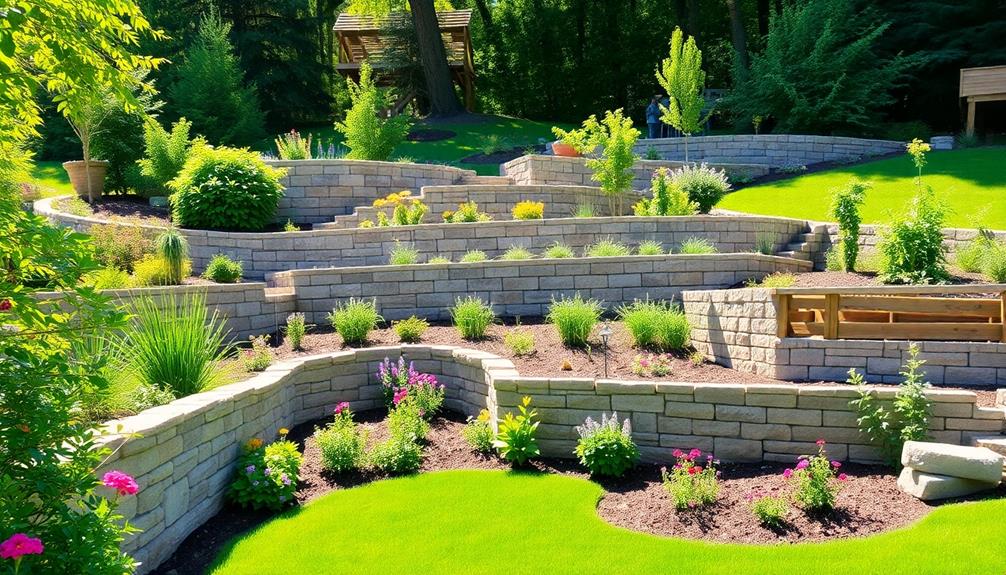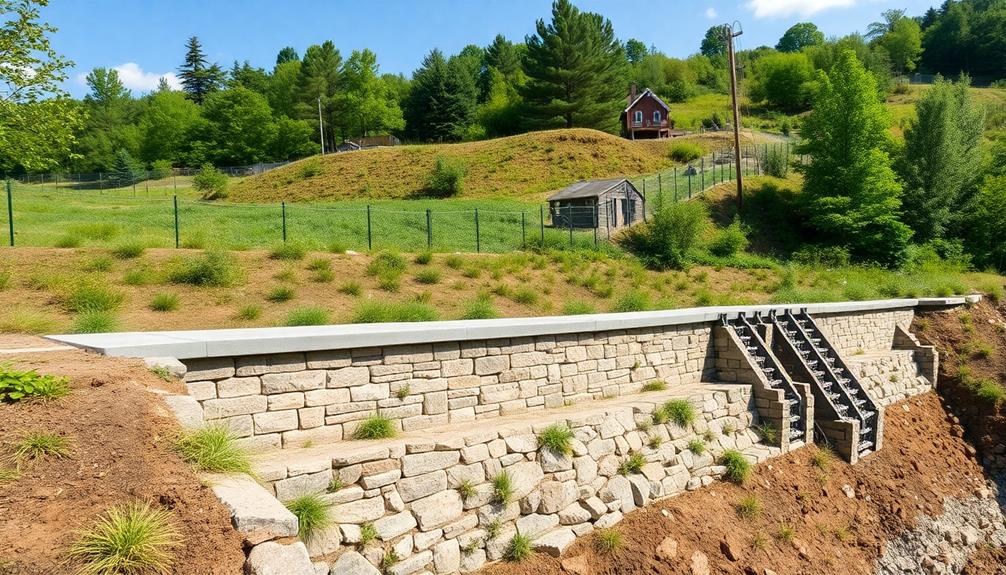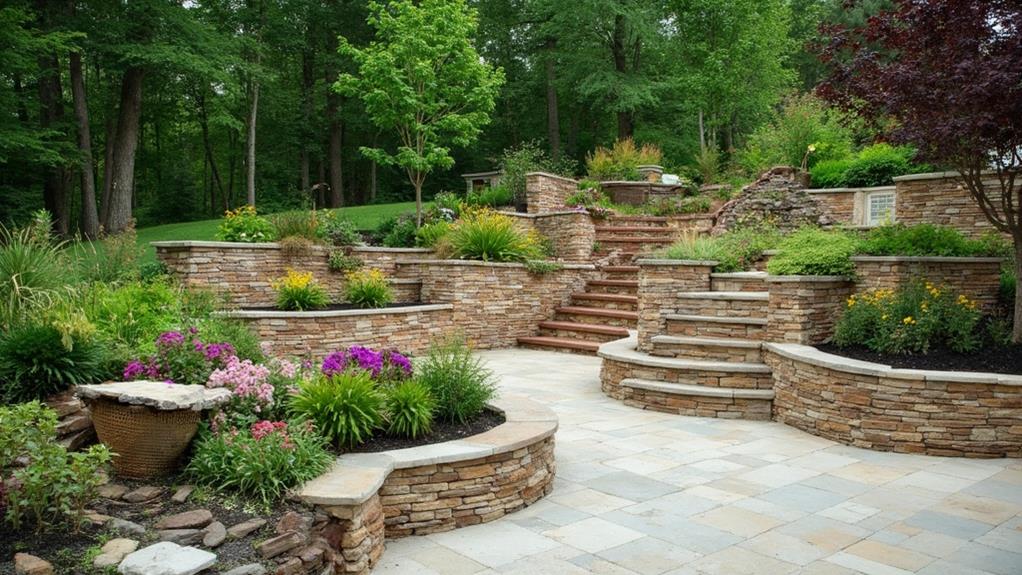When selecting retaining wall materials, thoroughly assess several key factors, including the wall's ability to blend seamlessly with the landscape through material choices such as stone, wood, or concrete, accounting for color and texture diversity. Prioritize materials with a high resistance to hydrostatic pressure and erosion to guarantee durability, which in turn preserves structural integrity and investment value. Consider sustainability by selecting eco-friendly options that are locally sourced or recycled, consequently reducing environmental impact. Evaluate the wall's compatibility with local climate conditions, focusing on water resistance and inclusion of proper drainage systems, which are essential for preventing water infiltration and maintaining stability. Continuation into these aspects will refine your decision-making process.
Table of Contents
ToggleWalls Contractor Highlights
- Opt for natural materials like stone or wood to blend seamlessly with the landscape.
- Assess material's resistance to water damage and ability to withstand hydrostatic pressure.
- Consider using locally sourced or recycled materials for reduced environmental impact.
- Ensure materials offer the necessary strength and durability for structural integrity.
- Evaluate compatibility of materials with the regional climate and building practices.
Purpose of Retaining Walls

Retaining walls serve a critical role in both functional and aesthetic aspects of landscape architecture, primarily by preventing soil erosion and stabilizing the terrain, thereby safeguarding structures and landscapes from the damaging effects of shifting soil. They are excellent for stairways and large walkways, providing customizable dimensions and location to fit specific design requirements.
Beyond their practical applications, these structures offer significant enhancements to landscape design by allowing for the creation of terraced gardens, level areas on sloped terrain, and the integration of varied plantings that elevate the overall visual appeal. Additionally, strategically constructed retaining walls are instrumental in managing water runoff, controlling drainage patterns to prevent flooding and soil saturation, ultimately contributing to the sustainability and resilience of both natural and built environments.
Preventing Soil Erosion
A fundamental purpose of retaining walls is to prevent soil erosion, particularly in areas prone to slope instability and land degradation. These structural elements serve as a vital line of defense against the forces of gravity and water, which can cause significant displacement of earth material, compromising not only the aesthetic appeal of landscapes but also the structural integrity of adjacent buildings.
By effectively holding back soil, retaining walls mitigate erosion by stabilizing loose earth, thereby reducing the risk of landslides and sediment runoff, which can degrade water quality and harm local ecosystems.
In crafting a retaining wall to combat soil erosion, material selection is paramount. Materials such as stone, concrete, and timber are often employed, each offering distinct advantages depending on site-specific factors such as soil type, climate, and the scale of erosion risk. In addition, the wall's design, which may include features like weep holes for drainage, is tailored to handle the hydrodynamic pressures that come with heavy rainfall or water flow.
As a result, a well-designed retaining wall not only fulfills its primary role of soil retention but also fosters a sense of security and resilience within communities, preserving landscapes for future enjoyment and utility.
Enhancing Landscape Design
How do retaining walls transform mere functional structures into intrinsic parts of landscape design? These elements serve as much more than practical solutions to soil erosion problems; they become key contributors to an aesthetically pleasing and cohesive outdoor environment.
When thoughtfully integrated into the landscape, retaining walls can delineate spaces, creating terraces that offer varying elevations and depths. These variations provide opportunities for planting, seating, and pathways, consequently enabling homeowners to fashion outdoor sanctuaries that meet both personal and communal desires for connection and beauty.
The material selection is pivotal in achieving the desired aesthetic impact; options such as natural stone, brick, or contemporary concrete blocks can complement or contrast with the existing surroundings. When harmonized with the architecture of the home and the natural landscape, retaining walls contribute to an overarching narrative that deepens the visual and emotional connection to the space.
Additionally, they can frame or even become part of focal points within the landscape, guiding the eye and enriching the experience of moving through the space. In other words, retaining walls offer homeowners not only structural integrity but also a canvas upon which to express creativity and cultivate a sense of belonging within their environment.
Managing Water Runoff
In addressing landscaping challenges, managing water runoff effectively is a pivotal function of retaining walls. These structures not only prevent soil erosion but also facilitate the proper direction and dispersion of water, minimizing potential damage to surrounding landscapes and properties.
When selecting materials for a retaining wall, it is indispensable to ponder their permeability and drainage capabilities. Natural stones, for example, have the innate ability to allow water to seep through, reducing hydrostatic pressure that can compromise wall stability over time. Additionally, incorporating a drainage system, such as gravel backfill or perforated pipes, enhances water management by directing excess water away from the wall.
Understanding the balance between structural integrity and environmental harmony makes it vital for homeowners and landscapers to select materials that align with these objectives. Materials such as concrete blocks, although less permeable, can be designed with weep holes to facilitate sufficient drainage. This strategic choice guarantees that communities feel secure in their investments, knowing that their properties are protected against the unpredictable forces of nature.
Benefits

The selection of suitable retaining wall materials offers multiple benefits, such as enhanced structural support, which guarantees stability and safety in landscapes subject to erosion or uneven terrain. For instance, materials like limestone walls not only provide excellent support and prevent erosion but also add an elegant and natural look to any yard or home.
Additionally, these materials contribute to improved aesthetic appeal, creating visually pleasing boundaries that harmonize with the surrounding environment. Moreover, by increasing property value and embracing environmentally sustainable practices, the right materials provide both economic and ecological advantages, making them a strategic choice for homeowners and developers alike.
Enhanced Structural Support
When considering the construction of retaining walls, opting for materials that offer enhanced structural support can considerably boost the longevity and reliability of the structure. High-quality materials, such as reinforced concrete, interlocking blocks, or treated timber, provide a sturdy foundation indispensable for maintaining the integrity of a wall under varying environmental conditions. Such materials are engineered to withstand significant pressure and load, which is especially beneficial in areas prone to soil erosion, heavy rainfall, or seismic activity.
Moreover, materials designed for structural reinforcement often incorporate advanced technologies and engineering principles, facilitating a more uniform distribution of forces across the wall surface. This not only reduces the risk of structural failure but also minimizes maintenance requirements over time. For community spaces and private properties alike, these features guarantee a safe and dependable boundary, fostering a sense of belonging and security amongst residents.
In addition, the use of materials that guarantee durability and strength aligns with sustainability goals, as they often require less frequent replacement and repair. Emphasizing proper material selection for enhanced structural support not only addresses practical needs but also contributes to creating resilient, cohesive communities that stand the test of time.
Improved Aesthetic Appeal
Elevating the visual appeal of retaining walls can markedly enhance the overall aesthetics of a landscape, integrating functionality with beauty. This transformation not only fosters a visually cohesive environment but also nurtures a sense of belonging within the community.
Retaining walls, when selected thoughtfully, offer distinctive features that cater to the varied stylistic preferences and communal values of homeowners and businesses alike.
- Material Selection: Opting for materials such as natural stone, brick, or wood can seamlessly blend the retaining wall with the surrounding landscape, providing a harmonious and unified appearance.
- Color Variety: Choosing from diverse color palettes allows the retaining wall to complement or contrast with the environment, adding depth and character to the outdoor space.
- Texture and Finish: Utilizing rough, smooth, or patterned finishes can introduce a tactile dimension to the wall, creating visual interest that invites admiration and inspection.
- Form and Design: Incorporating curves, angles, or terraces into the wall's construction offers a visually dynamic and engaging structure that enhances the overall aesthetic landscape.
Incorporating these elements thoughtfully guarantees that retaining walls do not merely serve a functional purpose but also contribute to a beautiful and inviting atmosphere.
Increased Property Value
Beyond enhancing aesthetic appeal, choosing the right materials for retaining walls can greatly impact property value. A well-constructed retaining wall using premium materials not only asserts structural integrity but also offers a sophisticated enhancement to any landscape, which prospective buyers find appealing.
By selecting high-quality, durable materials such as natural stone or well-finished concrete, property owners can make certain their retaining walls not only stand the test of time but also complement the architectural style of the home. This synergy often results in a cohesive landscape that naturally increases the desirability—and consequently, the value—of a property.
Moreover, incorporating innovative design elements or tailored finishes into retaining walls can distinguish a property in the market. Such bespoke features resonate well with potential homeowners, who often appreciate unique touches that reflect stealthy craftsmanship.
For those immersed in communities where design and value are deeply entwined, investing in superior wall materials can translate into a notable return on investment. At heart, by aligning aesthetic modernization with strategic material selection, property owners satisfy both personal gratification and practical financial considerations, reinforcing their place in a community characterized by valued and well-preserved homes.
Environmental Sustainability
Opting for sustainable materials in retaining wall construction can greatly enhance environmental benefits while maintaining the structural efficacy and visual appeal of the design. Embracing eco-friendly solutions aligns well with the growing awareness and appreciation for sustainable practices in architecture and landscaping, resonating deeply with communities seeking to foster a sense of belonging with the natural world around them.
When evaluating materials through the lens of environmental sustainability, consider the following benefits:
- Reduction of Carbon Footprint: Utilizing locally sourced or recycled materials minimizes transport emissions and conserves natural resources, contributing to lower overall carbon emissions.
- Biodiversity Support: Selecting materials that accommodate or enhance local flora and fauna encourages biodiversity, creating spaces that support the ecological network.
- Extended Lifecycle: Sustainable materials often possess increased durability and resilience, which means fewer replacements over time, reducing waste and environmental impact.
- Waste Minimization: By employing materials that generate minimal waste during production and installation, we can vastly reduce landfill contributions.
Incorporating these sustainable aspects into retaining wall projects reflects a conscientious effort to harmonize construction with environmental preservation. This thoughtful approach not only serves immediate aesthetic and functional needs but also fosters a lasting positive impact on the ecosystem, cultivating a deeper connection with nature.
Flood Prevention Capabilities

When considering the flood prevention capabilities of retaining wall materials, it's imperative to assess not only the intrinsic water resistance of various materials but also how effectively they integrate with proper drainage systems to mitigate water accumulation. The structural stability of these walls under increased hydrostatic pressure also plays a pivotal role in guaranteeing their efficacy and longevity in flood-prone areas. The table below summarizes key aspects involved in the selection and application of retaining wall materials for flood prevention.
| Consideration | Importance | Impact on Flood Prevention |
|---|---|---|
| Material Water Resistance | High | Prevents water infiltration |
| Proper Drainage Systems | Vital | Reduces water buildup |
| Structural Stability Concerns | Critical | Ensures longevity and safety |
Material Water Resistance
The selection of retaining wall materials with superior water resistance is pivotal to mitigating flood risks and enhancing structural integrity. Flood prevention is a critical consideration in retaining wall construction, requiring materials that can endure persistent exposure to moisture and resist deterioration over time. Selecting the most suitable materials guarantees not only longevity but also a sense of security for communities relying on these structures.
To guide your choices, consider the following factors when evaluating material water resistance:
- Porosity: Choose materials with low porosity to minimize water absorption. Materials such as concrete or natural stones are typically less porous, offering enhanced resistance.
- Durability: Materials like precast concrete blocks or reinforced earth systems exhibit high durability, helping withstand water pressure and preventing structural failure.
- Weathering Resistance: Opt for materials treated with sealants or coatings, which can provide an additional barrier against water infiltration and primitive frost effects.
- Compatibility and Construction: Verify that your selected materials are compatible with regional climates and adhere to construction best practices, providing peace of mind through their tested robustness.
Proper Drainage Systems
Selecting high-quality materials with exceptional water resistance is only one piece of the puzzle in effective flood prevention. A well-designed drainage system is equally critical in guaranteeing the longevity and functionality of retaining walls.
Proper drainage systems not only direct water efficiently away from the wall but also mitigate the buildup of hydrostatic pressure, a common cause of wall failure. To achieve optimal drainage, it is crucial to incorporate both surface and subsurface drainage components.
Perforated pipes, strategically placed at the base of the wall and wrapped in geotextile fabric, form the backbone of subsurface drainage systems; they capture excess groundwater and facilitate its seamless movement away from the structure. Complementing this are surface drainage solutions such as swales and graded slopes, which ensure precipitation runs away from the wall instead of pooling against it. It is also beneficial to use backfill composed of coarse aggregates, as these materials enhance drainage effectiveness by allowing swift passage of water through the soil.
When installing these systems, attention to detail and adherence to best practices guarantee community safety and satisfaction, fostering an environment of mutual understanding and trust among stakeholders.
Structural Stability Concerns
Ensuring structural stability in retaining walls is paramount for effective flood prevention. When selecting retaining wall materials, considering their ability to withstand hydrostatic pressure and potential erosion is critical. The following considerations are key to achieving structural stability while preventing floods:
- Material Selection: Choose materials that complement the surrounding environment and demonstrate high resistance to water damage. Concrete, stone, and reinforced earth structures often offer robust solutions.
- Engineering Design: Engage with professionals who can design retaining walls that account for specific site conditions, including soil type, slope, and potential water flow, ensuring stability against shifting or collapsing under pressure.
- Hydraulic Considerations: Implement features that effectively channel water away from the wall's base. This might include weep holes or perforated pipes, preventing excessive water buildup that can compromise wall integrity.
- Construction Techniques: Adopting proven construction methods, such as proper compaction of backfill materials and the inclusion of geosynthetics, provides additional strength and stability to the wall structure.
Walls Contractor FAQ
What Factors Affect the Cost of Different Retaining Wall Materials?
The cost of retaining wall materials is influenced by factors such as material durability, availability, transportation expenses, installation complexity, and local market demand. Ensuring community safety and aesthetics also drives material choice, impacting overall project expenditure.
How Do I Determine the Right Height for My Retaining Wall?
To determine the right height for a retaining wall, consider site-specific factors such as soil type, slope gradient, and intended purpose. Consult local regulations and engineering guidelines to guarantee safety and harmony within your community's landscape aesthetics.
What Are the Maintenance Requirements for Various Retaining Wall Materials?
Maintenance needs differ; for instance, timber requires regular sealing to prevent rot, whereas concrete may need occasional cleaning to manage efflorescence. Each material demands specific care, fostering longevity and ensuring the structure remains a cohesive part of your landscape.
Are There Eco-Friendly Options Available for Retaining Wall Materials?
Yes, there are eco-friendly retaining wall materials available, such as recycled concrete, sustainable timbers, and gabions filled with locally sourced stones. These choices support environmentally conscious construction, fostering a sense of community and responsibility toward nature.
How Do Different Materials Impact the Aesthetic Appeal of a Landscape?
Different materials can considerably impact a landscape's aesthetic appeal by offering various textures, colors, and finishes. Stone imparts timeless elegance, while concrete provides modern versatility. Harmonizing materials with the environment fosters a unified and welcoming outdoor space.







